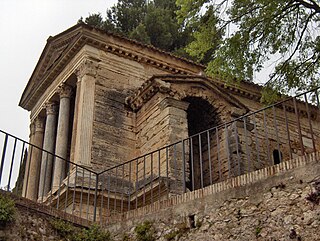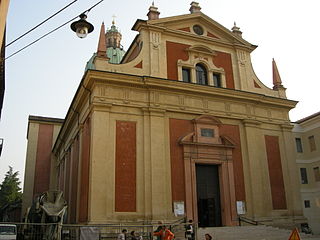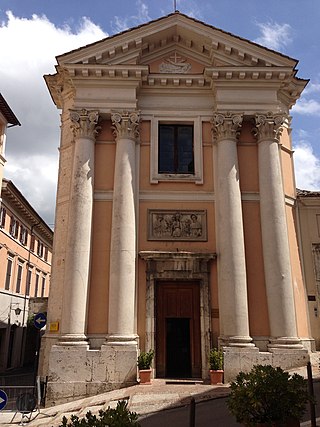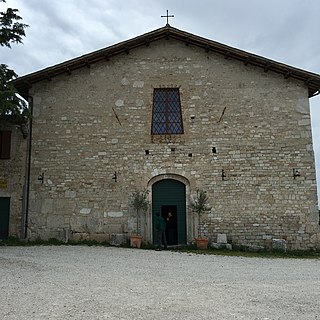
Spoleto is an ancient city in the Italian province of Perugia in east-central Umbria on a foothill of the Apennines. It is 20 km (12 mi) S. of Trevi, 29 km (18 mi) N. of Terni, 63 km (39 mi) SE of Perugia; 212 km (132 mi) SE of Florence; and 126 km (78 mi) N of Rome.

Ascoli Piceno is a town and comune in the Marche region of Italy, capital of the province of the same name. Its population is 45,630 but the urban area of the city has more than 93,000.

San Pietro in Valle is a medieval abbey in the comune (township) of Ferentillo in Umbria.

San Pietro in Bovara is a Romanesque and Gothic-style, Roman Catholic church and abbey located on Via Don Sturzo #2 in Bovara, a frazione of the town of Trevi, in the province of Perugia, region of Umbria, central Italy.

Atessa is an municipality in the province of Chieti, Abruzzo, south-eastern Italy. It is part of the Val di Sangro mountain community. It is the largest municipality in the province by extension and eighth by population.

San Gennaro extra Moenia is a church in Naples, Italy. It is located in the Rione Sanita on the large road that leads up to the Capodimonte museum and is an example of so-called paleo-Christian architecture in the city.

San Gennaro dei Poveri is a former monastery and church complex, later converted into a hospital for indigent located on Via San Gennaro dei Poveri #25 in the Rione Sanità, of the city of Naples, Italy. The elongated complex rises towards Capodimonte, lying just south of the domed Basilica dell'Incoronata Madre del Buon Consiglio.

The Church of Santa Maria Assunta is a basilica church on the island of Torcello, Venice, northern Italy. It is a notable example of Late Paleochristian architecture, one of the most ancient religious edifices in the Veneto, and containing the earliest mosaics in the area of Venice.

San Francesco is a basilica church in Siena, Tuscany, Italy.
Extra moenia is a Latin phrase that means outside the walls or outside the walls of the city.

The so-called Temple of Clitumnus is a small early medieval church that sits along the banks of the Clitunno river in the town of Pissignano near Campello sul Clitunno, Umbria]], Italy. In 2011, it became a UNESCO World Heritage Site as part of a group of seven such sites that mark the presence of Longobards in Italy: Places of Power.

Christianity and religion in general has always been an important part of the social and cultural life of Naples. It is the seat of the Archdiocese of Naples, and the Catholic faith is highly important to the people of Naples and there are hundreds of historic churches in the city. The Cathedral of Naples is the most important place of worship in the city, each year on September 19 it hosts the Miracle of Saint Januarius, the city's patron saint. In the miracle which thousands of Neapolitans flock to witness, the dried blood of Januarius is said to turn to liquid when brought close to relics said to be of his body: this is one of the most important traditions for Neapolitans.

San Paolo inter vineas is a Romanesque-style, Roman Catholic church in Spoleto, region of Umbria, Italy. The term inter vineas refers to its location outside town, among the vineyards.

San Pietro is a Baroque style, Roman Catholic church located on Via Campo Samarotto #1, with a facade along Via Emilia San Pietro, in the southwestern sector of central Reggio Emilia, Italy.

Sant'Ansano is a neoclassical-style, Roman Catholic church located in the town of Spoleto, in the province of Perugia, region of Umbria, Italy.

San Ponziano is a romanesque-style, Former-Benedictine monastery and church located in Spoleto, Province of Perugia, region of Umbria, Italy. The site is dedicated to St. Ponziano, the patron saint of Spoleto.
San Pietro Apostolo in Rosis in Ginestreto is a baptismal parish church or pieve, located on Via della Libertà #2 in the frazione of Ginestreto, a hamlet inland from Pesaro, in the province of Pesaro and Urbino, region of Marche, Italy.
San Pietro is a Gothic-style, Roman Catholic church in the center of the town of Leonessa, province of Rieti, region of Lazio, central Italy.

San Sabino is a Romanesque-style, Roman Catholic rural parish church located on vicolo San Sabino #22, east of SS685 and north of the historic center of Spoleto, region of Umbria, Italy.

The Abbey of San Felice e Mauro is a Roman Catholic complex including what is now the rural parish church of San Felice, a Romanesque and Gothic-style former monastery church, and the attached abbey, a former Benedictine monastery, now a rural inn and restaurant. The abbey is located just outside the hillside hamlet of Castel San Felice, which is less than a kilometer north of the small town of Sant'Anatolia di Narco. The valley area known as the Valenerina is located a handful of kilometers east of Spoleto, in the Province of Perugia, region of Umbria, Italy.


















